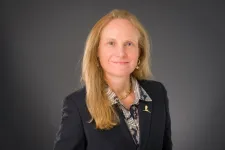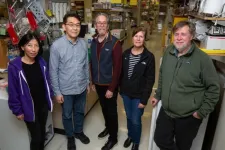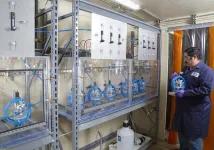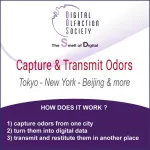(Press-News.org) At the heart of advancing semiconductor chip technology lies a critical challenge: creating smaller, more efficient electronic components. This challenge is particularly evident in the field of lithography, the process used to create intricate patterns on semiconductor materials (called wafers) for the production of chips. Lithography uses a kind of template, called a photomask — or just mask — for creating patterns on semiconductor wafers. The industry is always looking for methods that improve resolution and manufacturability for both masks and wafers, which will produce faster chips with higher yield of properly functioning chips.
Computational lithography techniques that improve resolution and pattern fidelity, such as optical proximity correction (OPC), have made significant strides in addressing these challenges by modifying the individual mask patterns to improve both mask and wafer printing. Inverse lithography technology (ILT) — a mathematically rigorous inverse approach that determines the mask shapes that will produce the desired on-wafer results — has been seen as a promising solution to many of the challenges of lithography for advanced chips. Since its introduction more than a decade ago, there have been numerous studies that demonstrate that curvilinear ILT mask shapes, in particular, produce the best wafer results.
However, until recently, the runtimes associated with this computational technique have limited its practical application to critical “hotspots” on chips. In 2019, an entirely new, purpose-built system was proposed, including a unique GPU-accelerated approach that emulates a single, giant GPU/CPU pair that can compute an entire full-chip ILT solution at once. This novel approach, systematically designed for ILT and GPU acceleration, made full-chip ILT a practical reality in production.
However, this approach relied on multi-beam mask writing, an important new development in mask writing that is pixel-based and so is shape-agnostic in terms of write-time. The question that remained was if the benefits of full-chip, curvilinear ILT could be extended to the variable shaped beam (VSB) mask writers that write rectilinear (and sometimes triangle) shapes rather than pixels, and that make up the majority of mask writers around the world today. While VSB writers create larger rectangular shapes quickly by writing one rectangular shot at a time, complex mask patterns can be an issue because the high number of small rectangles needed to create them would take too long to write.
Reporting their work in the Journal of Micro/Nanopatterning, Materials, and Metrology, the team at D2S, Inc. invented a method called mask wafer co-optimization (MWCO) with three insights: the mask writer and the wafer scanner are both low-pass filters; overlapping shots guided by mask/wafer simulation can create curvilinear shapes with fewer shots; by targeting the wafer pattern, instead of the mask pattern, one can create much simpler shots to print the correct wafer pattern. By using this double simulation, wafer print quality is iteratively optimized while manipulating VSB shot edges to produce rectilinear target mask shapes that are known to be writable on a VSB writer, with a known and acceptable shot count.
D2S and Micron Technology have demonstrated MWCO can reduce the wafer variation by 3x, and can improve the wafer process window by 2x compared to Micron OPC, indicating a substantial improvement in the precision and reliability of the lithography process. The write time for a full curvilinear ILT mask would be less than 12 hours, satisfying high-volume production requirements.
This means that all semiconductor manufacturers now can produce chips that are not only smaller but also have higher performance and lower power consumption, even if they do not have access to a multi-beam mask writer.
Read the research paper by Pang et al., “Make the impossible possible: use variable-shaped beam mask writers and curvilinear full-chip inverse lithography technology for 193i contacts/vias with mask-wafer co-optimization,” Journal of Micro/Nanopatterning, Materials, and Metrology 23(1), 011207 (6 February 2024) doi: 10.1117/1.JMM.23.1.011207.
END
Throwing lithography a curve
Mask wafer co-optimization makes it practical to create curved shapes using variable shaped beam mask writers
2024-02-20
ELSE PRESS RELEASES FROM THIS DATE:
St. Jude taps health care start-up veteran as first Senior Vice President of Tech Commercialization
2024-02-20
(MEMPHIS, Tenn., February 20, 2024) St. Jude Children’s Research Hospital has appointed Lisa Jordan, MS, MBA, as the institution’s first-ever Senior Vice President of Technology Commercialization to lead industry partnerships and the commercialization of innovations. Jordan will work with researchers to bring a greater number of new technologies, innovations and scientific breakthroughs to the clinic, enabling breakthroughs from St. Jude laboratories to benefit more patients.
The move, part of the institution’s 2022-2027 ...
Microplastics in every human placenta, new UNM Health Sciences research discovers
2024-02-20
A flurry of recent studies has found that microplastics are present in virtually everything we consume, from bottled water to meat and plant-based food. Now, University of New Mexico Health Sciences researchers have used a new analytical tool to measure the microplastics present in human placentas.
In a study published February 17 in the journal Toxicological Sciences, a team led by Matthew Campen, PhD, Regents’ Professor in the UNM Department of Pharmaceutical Sciences, reported finding microplastics in all 62 of the placenta samples tested, with concentrations ranging from 6.5 to 790 micrograms ...
Examining a century of change in a New York City urban forest
2024-02-20
There haven’t been many long-term studies on urban forests, but data collected from the Thain Family Forest, which the New York Botanical Garden (NYBG) has been stewarding for more than a century, has provided an opportunity for scientists from The Forest School at YSE to study a century of changes of its composition.
Using inventory data from 1937-2021, Eliot Nagele ’21 MF, who initiated the research while a forester at Thain and a student at YSE, documented changes in forest structure, diversity, and composition to assess the health of the forest over time. ...
Salk scientists discover new target for reversible, non-hormonal male birth control
2024-02-20
LA JOLLA (February 20, 2024)—Surveys show most men in the United States are interested in using male contraceptives, yet their options remain limited to unreliable condoms or invasive vasectomies. Recent attempts to develop drugs that block sperm production, maturation, or fertilization have had limited success, providing incomplete protection or severe side effects. New approaches to male contraception are needed, but because sperm development is so complex, researchers have struggled to identify parts of the process that can be safely and effectively tinkered ...
Unlike men, for professional women, having high-status connections can backfire
2024-02-20
Women working in organizations are frequently encouraged to cultivate connections to high-status individuals based on a prominent social network theory. But new research conducted in China and the United States suggests that having high-status connections can backfire for women.
The study, by researchers at Carnegie Mellon University and the University of Michigan, appears in Organizational Science.
“Our findings reveal a social-network dilemma for women that is contrary to a widely accepted belief that women should build their network with high-status individuals,” said Catherine Shea, Assistant Professor of Organizational Behavior and Theory at Carnegie Mellon's Tepper School ...
Time watching videos may stunt toddler language development, but it depends on why they're watching
2024-02-20
DALLAS (SMU) – A new study from SMU psychologist Sarah Kucker and colleagues reveals that passive video use among toddlers can negatively affect language development, but their caregiver’s motivations for exposing them to digital media could also lessen the impact.
Results show that children between the ages of 17 and 30 months spend an average of nearly two hours per day watching videos – a 100 percent increase from prior estimates gathered before the COVID pandemic. The research reveals a negative association between high levels of digital media watching and children’s vocabulary development.
Children exposed to videos ...
SwRI to host second Automotive Corrosion Symposium
2024-02-20
SAN ANTONIO — February 20, 2024 —Southwest Research Institute will host its second Automotive Corrosion Symposium in Detroit April 11-12. The event, first held in 2022, is designed to foster communication among corrosion experts from within automotive original equipment manufacturers (OEMs) as well as material, paint and other automotive suppliers over a wide spectrum of industry-identified corrosion issues.
“Corrosion is a concern within the automotive industry, not just for cosmetic reasons, but because it can affect functionality and safety,” said SwRI Staff Engineer James Dante, one of the organizers ...
Rutgers professor of computer science is named Sloan Fellow
2024-02-20
A Rutgers professor who studies and improves the design of algorithms – human-made instructions computers follow to solve problems and perform computations – has been selected to receive a 2024 Sloan Research Fellowship.
Aaron Bernstein, an assistant professor in the Department of Computer Science in the School of Arts and Sciences at Rutgers University-New Brunswick, was named one of 126 researchers drawn from a select group of 53 institutions in the U.S. and Canada. The award honors extraordinary creativity, innovation and the potential to become a scientific ...
Challenge Announcement: Global Initiative to Digitalize Scents by the Digital Olfaction Society Revolutionary Scent Digitalization Challenge 2025: Capturing Aromas to Reproduce Anywhere
2024-02-20
Tokyo, The Digital Olfaction Society (DOS) announces a global initiative for 2025, aiming to digitize and transmit scents from various locations around the world for reproduction in Tokyo. This project intends to capture a wide range of fragrances representing the cultural diversity of the globe, leading to a significant development in Tokyo.
Invitation for Worldwide Participation
DOS invites teams from around the world to participate in this initiative. Whether located in major cities such as Berlin, New York, Dubai, or any place with a distinctive aroma, contributions ...
VUB researchers assemble patterns of micro- and nanoparticles
2024-02-20
Researchers from the Department of Chemical Engineering at the Vrije Universiteit Brussel, Riga Technical University and the MESA+ Institute at the University of Twente have succeeded in arranging very small particles (10 µm to 500 nm, 10 to 100 times thinner than a human hair) in a thin layer without using solvents. This is a hugely important first step towards developing a new generation of sensors and electronics for a wide range of applications.
“Common methods based on crystallising solutions are ...
LAST 30 PRESS RELEASES:
Making lighter work of calculating fluid and heat flow
Normalizing blood sugar can halve heart attack risk
Lowering blood sugar cuts heart attack risk in people with prediabetes
Study links genetic variants to risk of blinding eye disease in premature infants
Non-opioid ‘pain sponge’ therapy halts cartilage degeneration and relieves chronic pain
AI can pick up cultural values by mimicking how kids learn
China’s ecological redlines offer fast track to 30 x 30 global conservation goal
Invisible indoor threats: emerging household contaminants and their growing risks to human health
Adding antibody treatment to chemo boosts outcomes for children with rare cancer
Germline pathogenic variants among women without a history of breast cancer
Tanning beds triple melanoma risk, potentially causing broad DNA damage
Unique bond identified as key to viral infection speed
Indoor tanning makes youthful skin much older on a genetic level
Mouse model sheds new light on the causes and potential solutions to human GI problems linked to muscular dystrophy
The Journal of Nuclear Medicine ahead-of-print tip sheet: December 12, 2025
Smarter tools for peering into the microscopic world
Applications open for funding to conduct research in the Kinsey Institute archives
Global measure underestimates the severity of food insecurity
Child survivors of critical illness are missing out on timely follow up care
Risk-based vs annual breast cancer screening / the WISDOM randomized clinical trial
University of Toronto launches Electric Vehicle Innovation Ontario to accelerate advanced EV technologies and build Canada’s innovation advantage
Early relapse predicts poor outcomes in aggressive blood cancer
American College of Lifestyle Medicine applauds two CMS models aligned with lifestyle medicine practice and reimbursement
Clinical trial finds cannabis use not a barrier to quitting nicotine vaping
Supplemental nutrition assistance program policies and food insecurity
Switching immune cells to “night mode” could limit damage after a heart attack, study suggests
URI-based Global RIghts Project report spotlights continued troubling trends in worldwide inhumane treatment
Neutrophils are less aggressive at night, explaining why nighttime heart attacks cause less damage than daytime events
Menopausal hormone therapy may not pose breast cancer risk for women with BRCA mutations
Mobile health tool may improve quality of life for adolescent and young adult breast cancer survivors
[Press-News.org] Throwing lithography a curveMask wafer co-optimization makes it practical to create curved shapes using variable shaped beam mask writers







